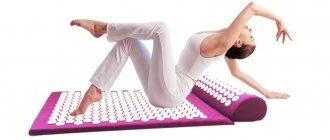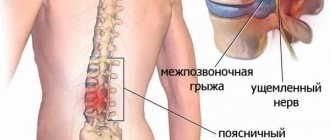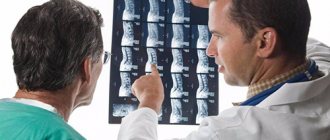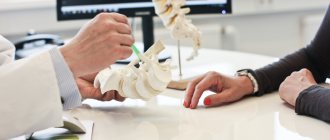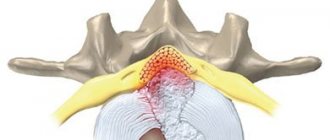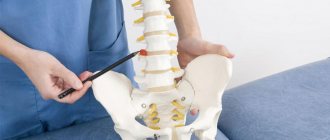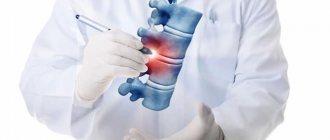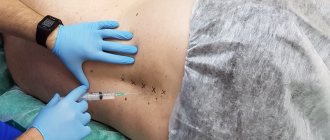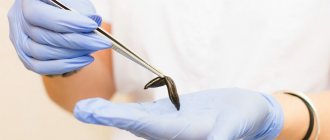The formation of intervertebral hernia in the cervical, thoracic and lumbosacral regions causes chronic back pain, with characteristic weakness of the lower as well as upper extremities. All this causes a lot of problems when moving and performing daily duties. Non-surgical as well as post-operative rehabilitation techniques, which include a diet for spinal hernia, as well as a set of special exercises, massages and manual therapy, will eliminate these symptoms.
The importance of dietary nutrition for intervertebral hernia
Improper nutrition contributes to the fact that the intervertebral discs do not receive the necessary substances that ensure the normal functioning of the sacral, lumbar and thoracic regions.
Nutrition of the discs and removal of metabolic products from them occurs through the surrounding ligaments and muscles. A lack of essential nutrients leads to a decrease in the functional activity of muscles and ligaments and, as a result, excessive wear of the discs. The result is disastrous: the development of osteochondrosis followed by the formation of a hernia.
Restoring normal nutrition of the intervertebral discs is possible only by performing certain physical exercises and following a special diet, including foods rich in vitamins and microelements.
A balanced diet to restore the cartilage tissue of the spine is a primary task in the treatment of a hernia.
Excess weight is the number 1 enemy of the spine
The detrimental effect of excess weight on the spine is not an exaggeration. Excess weight is the culprit of enormous loads and great pressure on the musculoskeletal system, as well as intervertebral discs. Under the influence of excessive loads, the nerve roots are compressed, causing acute pain, and the cartilage discs wear out, which leads to their early aging.
If you are overweight, the following are also impaired:
- biochemical processes,
- metabolism,
- proper blood supply,
- functioning of organs (joints, muscles, cartilage, etc.).
If you have a diagnosis of intervertebral hernia, it is important to choose a balanced diet that will help stop the complications that arise under the pressure of excess weight
Thanks to a thoughtful, proper diet, it becomes possible to achieve weight loss.
Treatment of hernias in our clinic
Various surgical and conservative treatment methods are used to treat herniated intervertebral discs. Surgical methods mainly involve mechanical “cutting” of the disc and it is clear that in this case the functions of the disc cannot be fully restored. Surgical methods are used when the hernia has already reached a large size, and conservative treatment has failed to produce positive results.
Treatment of hernias without surgery
In our clinic, for the treatment of intervertebral hernias, we successfully use only conservative methods that are highly effective - more than 90% and allow us to do without expensive operations.
What needs to be done to make hernias disappear?
Naturally, there is no universal answer that would be suitable for all patients. But the general principles of hernia treatment are well known to us, and the specific program is selected individually.
When treating hernias it is necessary:
- Relieve pain syndrome
- improve nutrition of the affected area
- relieve possible muscle spasms
- Strengthen the muscle corset
- improve metabolic processes
To achieve these goals, our clinic doctors have all the necessary equipment at their disposal:
- Shock wave therapy Zwave,
- Pulse currents, electrophoresis,
- Detensor - therapy (traction),
- Ultrasound Phonophoresis,
- Hiwamat deep massage,
- Acupuncture physiotherapy
- Laser therapy,
- Pressotherapy,
- Magnetotherapy,
- Bubnovsky simulator,
Fundamental rules of proper nutrition
In order for a diet for lumbar intervertebral hernia to bring maximum benefit, you need to understand its principles. The step-by-step method of proper nutrition is as follows:
- The basic and constant rule that must be followed when eating is to know when to stop and never overeat.
- To get rid of excess weight, strict control over your diet is necessary. Eating food should be divided into small portions and evenly distributed over 5-6 meals.
- The last meal can be a time chosen individually, but no later than four hours before bedtime. If hunger takes over, nutritionists recommend drinking low-fat kefir, yogurt, or eating some fruit.
- Including spinal-healthy vegetable and fish dishes, as well as fruit salads, in your diet.
- Limit alcohol, as well as flour, sweet, smoked and sausage products.
- In order not to break down and eat forbidden food, you do not need to lead a completely ascetic lifestyle. A balanced approach will help with this. Sometimes, as a surprise or reward for following all the daily dietary rules, you can allow yourself ice cream or cookies, only in small doses.
Compliance with drinking regime
Proper nutrition for a hernia of the lumbar spine also includes a drinking regime.
Water plays a key role in developing strength, performing a shock-absorbing function, and normalizing pressure inside the disc. Insufficient fluid intake leads to the disc drying out and losing its elasticity.
The daily water intake for a person suffering from intervertebral hernia should be 1.5-2 liters. In addition, it is important to remember to limit the consumption of drinks that have a diuretic effect (green tea, coffee, etc.), as well as any juices on an empty stomach, which place a greater burden on the pancreas
Vitamins + microelements = healthy spine
The role of vitamins (A, B, C, D) and microelements (phosphorus, magnesium, calcium and manganese) in strengthening the human skeletal system, as well as in the metabolic process in the body, is enormous. In this regard, they must be included in the mandatory daily diet. Therefore, it is important to know how to eat with a spinal hernia in order to consume the necessary foods that are a source of vitamins. The human body can obtain all of the above substances by consuming the following products:
- fish, liver, eggs, cheese, carrots and pumpkins, peaches and melons - sources of vitamin A, which promotes the production of collagen, strengthens and restores cartilage tissue, and is also actively involved in regeneration;
- buckwheat and oatmeal, seafood, fermented milk products, grapefruits, bananas and oranges, soybeans and corn - they serve as a source of vitamin B, which promotes the restoration process of connective tissue, as well as producing thiamine and pyridoxine, drugs that affect the nervous system, reducing pain syndromes;
- black currants, rose hips, apples, sweet peppers, sea buckthorn, rich in vitamin C, which improves blood circulation and normalizes the structure of the walls of blood vessels (due to the fact that it does not accumulate, it should be consumed daily);
- fish oil, milk and butter - products that promote the production of vitamin D, which is the most important stimulator in the formation of bone tissue;
- fish dishes, salads, legumes and cheeses containing phosphorus - a building material that strengthens the entire skeletal system, including the spine, and also prevents bone fragility;
- seaweed, egg yolk, almonds and walnuts, celery and potatoes, offal of animals and birds containing manganese, which ensures normal cellular nutrition;
- natural cheeses, spinach and cucumbers, sunflower seeds rich in magnesium, which is responsible for bone strength;
- cauliflower and white cabbage, red beets, coarse corn flour, animal offal (kidneys, liver), from which the body receives calcium.
Regeneration of cartilage tissue
Adequate nutrition for a herniated cervical spine, as well as the sacral and thoracic spine, is simply irreplaceable when restoring the skeletal system. In order for damaged cartilage to fully recover, it will require daily replenishment with the components of cartilage tissue - glycosaminoglycans, polymers of natural origin. You can replenish the body’s increased need for natural polymers and minerals by including various nutrients in your daily diet:
- To quickly restore damaged cartilage tissue, the body should receive from 60 to 100 grams of protein per day. Proteins and collagen are the main components of intervertebral discs, which maintain their correct shape and elasticity, and also accelerate the process of scarring of the damaged area. To ensure a continuous regeneration process, it is necessary to evenly distribute the protein menu throughout the day. The daily diet should include foods that are a source of protein: natural cheeses, low-fat fish, poultry and cottage cheese, eggs and cereals.
- To improve the tone and nutrition of cartilage tissue, as well as the removal of toxins that are formed during injury, it is necessary to ensure sufficient water intake (fluid takes up a large volume in the intervertebral disc).
- Biologically active minerals and vitamins play an invaluable role in the accelerated restoration of energy processes necessary for the regeneration of cartilage, as well as the density and strength of bone tissue.
What is a herniated disc?
The central part of the intervertebral disc is the nucleus pulposus - a highly stretchable, elastic formation of type II collagen with a jelly-like consistency.
The protective functions of the nucleus are performed by the dense fibrous ring surrounding it, consisting of type I collagen . The fibers of both types of collagen, in addition to performing the function of reinforcement, retain hyaluronic acid in the intervertebral disc, which, in turn, binds water.
The disc is composed of collagen and hyaluronic acid
The anatomical structure formed in this way is capable of withstanding high pressure and, by combining the vertebrae into a single whole, ensures mobility and flexibility of the spinal column, and also acts as a shock absorber.
When, as a result of the influence of negative factors - injuries, dystrophic and inflammatory processes in the spine, excessive physical activity - the nucleus pulposus is displaced, the fibrous ring ruptures with protrusion of part of the disc between the vertebrae, a hernia is formed.
Location of hernias
Based on location, types of spinal hernia are classified and designated as follows::
- C - hernia of the cervical (cervical) region;
- Th —thoracic (thoracic) hernia;
- L —lumbar (lumbar) hernia.
A hernia can occur in one of three parts of the spine
Most often - in 64% of cases - a lumbar hernia is diagnosed, since the load carried by this segment of the spine is maximum. The second most common, in approximately every third case, is a hernia of the cervical spine. And extremely rarely - their share is only 6% - hernias are observed in the thoracic region .
Foods that help restore cartilage
In order for treatment to be most effective, you need to know exactly what nutrition will bring the greatest benefit. The most useful and recommended diet for a hernia should look like this:
- a source of antioxidant effects can be the consumption of large amounts of fruits (pears, apples, citrus fruits) and vegetables (sweet peppers and pumpkin, cabbage and spinach);
- Fermented milk products, fish oil, salmon, herring and cod liver, eggs, almonds will become indispensable in the formation and regeneration of bone tissue;
- to relieve pain and stop the process of destruction of cartilage tissue, it will be useful to consume offal, cereals, pine nuts, raisins, avocados, and mushrooms;
- Regular consumption of seaweed, pistachios, hazelnuts and other nuts will help improve the metabolic process and restore nutrition to cartilage;
- to effectively protect cartilage tissue and slow down the progression of dystrophic changes in joints, it is recommended to use gelatin and jelly from animal cartilage (ears, tails), which are a rich source of chondroprotectors;
- Since cartilage consists of a large amount of liquid, you need to drink one and a half to two liters of water daily.
General recommendations for patients with lumbar hernia
Diet for intervertebral hernia is considered as an integral element of therapy, but there are other useful recommendations that will help quickly normalize the condition during an exacerbation.
- It is important to keep your own weight within normal limits. This is facilitated not only by adjusting the diet, but also by increasing physical activity. You need to start small - walk more, take walks in the fresh air, and, if possible, give up sedentary work.
- Strength sports, excess activity, heavy lifting - all this is dangerous for patients with a hernia, but this does not mean that you have to forget about sports. A great option is swimming. Finding the body in such a dense environment as water helps strengthen the lower back, relieve pain and improve blood circulation.
- Simple therapeutic exercises will also be beneficial. At home, after the doctor’s approval, you can perform smooth bends, turns, and rotations of the body.
Another important detail is the need for drug treatment. Intervertebral hernia can be treated exclusively through proper nutrition and a set of physical procedures only in the early stages. But, unfortunately, many patients ignore alarming symptoms and seek help only when drug intervention is required. In this case, the diet will serve as a supplement that increases the effectiveness of therapy.
Prohibited products
Since nutrition can bring both benefit and great harm, it is necessary to know which foods should either be excluded from the diet or consumed in limited quantities. In case of a vertebral hernia, the following rules should be followed:
- Products made from premium flour and those containing sugar are considered absolutely useless for disc regeneration. The industrial processing process removes from them all the minerals and vitamins necessary and beneficial to the body.
- Store-bought meat products, sausages, sausages and bacon contain a large number of flavor enhancers, dyes, and stabilizers. Everything looks appetizing and tasty, but in fact they only aggravate the exacerbation of the disease.
- Salt, which is deposited in bones and joints, is also considered no less harmful to the spine. Therefore, you should limit its consumption and try to avoid salty foods (marinades, ketchups, nuts).
- It is prohibited to consume alcohol, smoked meats processed in special solutions, margarines and spreads that destroy cartilage tissue.
The importance of proper nutrition for the spine
One of the reasons for the formation of an intervertebral hernia is a deficiency of essential substances that nourish the disc tissue . Its normal anatomical and physiological parameters are ensured due to indirect blood circulation carried out in the process of diffusion from the peripheral vessels of the disc itself and the adjacent vertebral body.
Maintaining optimal disc status requires, in addition to nutrition, the removal of metabolic waste products . With dystrophic changes in the muscular-ligamentous tissues of the spine, oxygen and nutritional metabolism is disrupted, which increases the risk of hernia formation or aggravates the already advanced process of its formation.
In addition, excess body weight, which creates excessive loads on the spinal column and causes disturbances in the course of biochemical processes in the body, is also considered a factor initiating the development of a spinal hernia.
In view of this, proper nutrition and a therapeutic diet allow:
- remove toxic metabolic products from the body;
- balance the content and replenish the deficiency in the body of nutrients and vitamins and minerals;
- stop pathological processes and stimulate regenerative processes in the tissues of the spinal disc;
- ensure a healthy pace of weight loss and weight loss, thereby reducing excess pressure on the lumbar spine.
Video: “How does nutrition affect the spine?”
Allowed and prohibited foods for spinal hernia
In case of spinal hernia, it is advisable to include in the menu those products whose consumption ensures the construction, nutrition and regeneration of osteochondral tissues:
- fruits and vegetables with a large amount of dietary fiber (fiber), which help improve metabolic processes (white cabbage, Jerusalem artichoke, carrots, spinach, raspberries, strawberries, apples);
Pay attention to the list of permitted and prohibited products for spinal hernia: lean beef and veal, as well as offal, dietary meat of rabbit, turkey, chicken;- bread with bran or wholemeal flour;
- any cereal porridge without the addition of animal fats;
- low-fat fermented milk products;
- nuts;
- eggs;
- legumes;
- fatty varieties of ocean fish;
- seafood;
- caviar;
- jellied meat and fish dishes (jellied meat, jelly, aspic).
Exclude from the diet or limit the consumption of food, during the preparation of which the beneficial substances contained in the original products are destroyed, and which can provoke the development of inflammatory processes and increased pain.
These include:
- any excessively salty, spicy, fatty foods;
- confectionery products made from premium flour using sugar and its substitutes, margarine, butter and spreads;
- smoked meats;
- pickles and marinades;
- drinks containing carbon dioxide;
- fast food.
Video: “Herniated disc and osteochondrosis”
Weekly diet
When drawing up a diet menu for a vertebral hernia for a week, each person must take into account the individual characteristics of the course of the disease, after consulting with their doctor. If your health deteriorates after consuming any product, it must be excluded from the diet. You can take the following sample menu as a basis:
- Breakfast:
– one boiled egg;
– 100 grams of oatmeal;
- Lunch:
– fresh fruit salad (banana, orange, apple, kiwi, etc.)
- Dinner:
– 150 mg of broth or low-fat mushroom soup;
– 200 – 250 g of fish;
- vegetables.
- Afternoon snack:
– 150 g low-fat cottage cheese.
- Dinner:
– 200 g of lean poultry meat;
– 100 g buckwheat porridge;
– 100 g of white cabbage salad with cucumbers.
- Second dinner:
– a glass of low-fat kefir or yogurt.
- Liquid during the day:
– 1.5 – 2 liters of water + juice, tea, dried fruit compote.
Drinking regimen for spinal hernia
The elasticity and resilience of the tissues of the intervertebral disc is ensured due to the high content (about 90%) of water in it.
A constant lack of moisture leads to the disc drying out and becoming thinner. This leads to the loss of its shock-absorbing properties and other destructive changes.
In addition, lack of fluid is one of the reasons for blood thickening, which negatively affects metabolism and oxygen exchange in the cells and tissues of the whole body, not excluding the spinal column. Therefore, for patients with protrusions and hernias of the spine, it is vitally important to maintain a constant water balance , observing a certain drinking regime.
Correct adherence to it does not consist in quenching thirst or drinking plenty of food, but in drinking the required amount of water without mixing it with food.
Nutritionists recommend drinking 2.5-3 liters of bottled or filtered water during the day , evenly distributing this amount between meals.
Drinking regime is of particular importance for the health of the spine. Pay attention to the water standards for everyone
It is best to pre-settle tap water, since it has a fairly high content of hardness salts, and its consumption can negatively affect the condition of the intervertebral discs. In hot weather, when sweat glands work overtime and moisture evaporates rapidly from the surface of the skin, there is a risk of dehydration. Therefore, the amount of water you drink can be increased.
However, the recommended daily intake is not required for everyone and may vary. There are methods by which the doctor, based on individual physical indicators (age, height, weight, physical activity), calculates the optimal rate and regimen of water consumption for a patient with a diagnosed spinal hernia.
Basic rehabilitation techniques for the diagnosis of spinal hernia
The main goal of complex conservative therapy for spinal hernia is to eliminate pain, relieve inflammation and avoid surgery.
One of the most common techniques aimed at stimulating the regeneration process is physical therapy: electrophoresis, acupuncture, and dynamic currents.
To reduce pain and relieve the feeling of stiffness, an additional technique of therapeutic massage is successfully used.
To restore blood supply to the spinal muscles, manual therapy is successfully used with an individual approach to each patient.
Vitamins and minerals needed for spinal hernia
Vitamins and minerals, which are catalysts and stimulants of all biochemical processes , are not synthesized in the body independently, but come from the food consumed (with the exception of vitamin D).
With a lack of these nutrients, tissue nutrition noticeably deteriorates and metabolism slows down. Therefore, the choice of diet for patients with lumbar disc herniation should be aimed at maximizing the presence of foods that supply important nutrients in the diet.
Sources of vitamins and minerals for spinal hernia
- Vitamin A , necessary for the production of collagen, which gives elasticity to cartilage tissue, is found in beef liver, dairy products, carrots, orange pumpkin, and apricots.
- B vitamins , participating in the metabolism of cholesterol and amino acids, improve metabolism and help reduce pain. Their sources are fermented milk products, eggs, buckwheat, barley, oatmeal, corn, nuts, soybeans, oranges, bananas.
- Vitamin D stimulates the absorption of magnesium, which is required for the skeletal system, and is found in large quantities in eggs, butter, cod liver, fish oil, and milk.
- Vitamin C is necessary to strengthen connective tissues; without it, the body cannot fully absorb calcium, the main building material of bones. The deficiency of ascorbic acid is compensated by eating citrus fruits, sweet peppers, melons, strawberries, potatoes, all types of cabbage, both fresh and sauerkraut, tomatoes, garlic, and herbs.
- The lack of calcium is compensated by consuming dairy products, mainly cottage cheese.
- Magnesium , the main component of intracellular fluid and an active participant in protein-carbohydrate metabolism, helps maintain ionic balance in liquid media. Sources of the mineral are nuts, legumes, cucumbers, cheese.
- Phosphorus , a kind of nourishment for bone tissue, is found in fish, green varieties of lettuce, cabbage, soybeans, and bran.
- Manganese , necessary for joint mobility and bone strength, is obtained by the body by consuming seaweed, legumes, baked potatoes with skin, bananas, cheese, almonds, poultry giblets, and walnuts.
Vitamin complexes
In cases where vitamins and minerals obtained from food do not meet the body’s needs for them, they resort to the prescription of vitamin-mineral complexes (VMCs) - special supplements, the formula of which combines the necessary micronutrients in optimal quantities and concentrations.
Vitamin therapy is also prescribed in the case of certain pathological conditions . These include:
If necessary, vitamin complexes may be prescribed to treat a herniated disc; damage to the vertebral vessels or nerve nodes of the spinal cord due to prolapse of the intervertebral disc;- development of sequestered hernia;
- diabetes mellitus and other endocrine disorders, as well as osteopenia and osteoporosis due to spinal hernia;
- pronounced inflammatory processes in the localization of hernial formation (as an addition to the main therapy);
- gastrointestinal diseases in which phosphorus, calcium and magnesium are not absorbed from food;
- the presence of diseases that lead either to disruption of the synthesis of vitamin D in the body, or to its poor absorption.
The most effective IUDs for lumbar disc herniation:
| Alphabet | with an emphasis on vitamin D content |
| Merz | balanced vitamin B complex |
| Multitabs | especially recommended for women due to the content of antioxidant vitamins, including H, F, K |
| Centrum | helping to improve immune capabilities and enhance the regenerative properties of the body |
| Vitrum | containing a complex of all vitamins and minerals necessary for spinal hernia |
Find out more about the treatment of herniated disc:
- Treatment of spinal hernia during pregnancy and methods of delivery for pathology
- You will find out whether you can take chondroprotective drugs for a herniated disc by going here
- Read more about the treatment of back hernia during exacerbation at the link
Postoperative diet
The postoperative diet should be more strict than when a hernia occurs. Since a person who has undergone surgery leads a sedentary life, he needs food that is quickly digestible and does not cause bloating or intestinal obstruction. Therefore, it is necessary to exclude semolina, wheat porridge, rice, pears, and bread from the diet.
After surgery, the patient needs to strengthen weakened back muscles. For this purpose, an individual program for the restoration of muscle tissue has been developed.
Purpose of dieting
Doctors explain that almost every disease requires dietary adjustments. Lumbar hernia is no exception. There are several reasons why a patient with this pathology is prescribed a diet.
- Weight normalization . It is known that intervertebral discs are often damaged in people who are prone to obesity. Therefore, for successful treatment and further prevention it is necessary to exclude the influence of provoking factors. Following a diet that involves controlling portion sizes, as well as strict dosing of fats and carbohydrates, will normalize weight and reduce the unpleasant symptoms of a herniated disc.
- Metabolic restoration . The first pathological changes in intervertebral hernia can occur against the background of impaired metabolism. Therefore, in the early stages of pathology, diet can really help eliminate the problem.
- Getting rid of salt deposits . The processes of accumulation of salts in the periarticular space are always accompanied by pain. This will not be a direct cause of the hernia, but may contribute to its recurrence even after treatment. For this reason, doctors advise restructuring the diet and eliminating from it all foods that contribute to the deposition of salts.
- Restoration of blood circulation . Discs that are deformed and extend beyond the vertebrae compress not only the nerve endings, but also the blood vessels that feed them. This problem provokes stagnation and hypoxia in the lumbar region. Consequently, the patient requires food that will increase the intensity of blood supply.
- Tissue restoration . For any type of hernia, it is important to ensure sufficient intake of minerals (calcium, magnesium, phosphorus and manganese) into the body. Vitamins, which are designed to speed up the absorption of micro- and macroelements, will also not be superfluous.
Intervertebral discs are often damaged in people who are prone to obesity
On a note! Doctors explain that proper nutrition for a herniated spine solves several problems at the same time and is considered a full-fledged therapeutic agent that is appropriate at any stage of the development of the disease.
Forbidden food
There are a number of foods that are not recommended for lumbar hernia. Restrictions apply to salty foods, as they lead to the formation of salt deposits in the joints. Fatty foods are dangerous because they increase cholesterol.
The list of prohibited products is as follows:
- fatty food;
- smoked meats and sausages;
- bacon;
- pork;
- canned meat;
- roast;
- pickles and marinades;
- white bread, pastries;
- fast food;
- mayonnaise and other sauces;
- most sweets: sweets, cakes.
It is important to limit salt and sugar. Coffee and milk in large quantities are not recommended for drinks.
